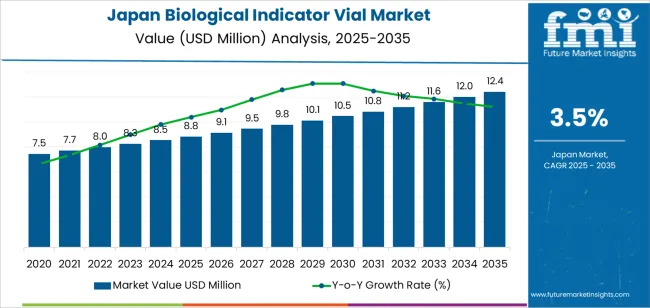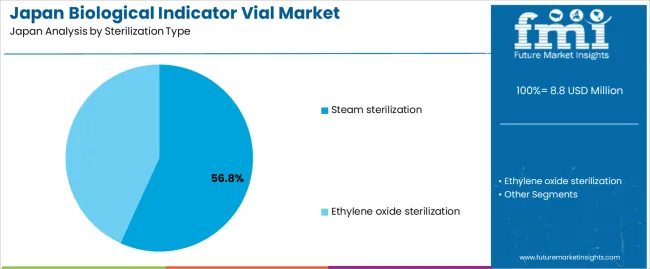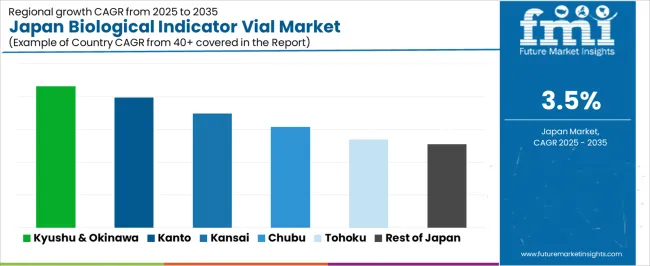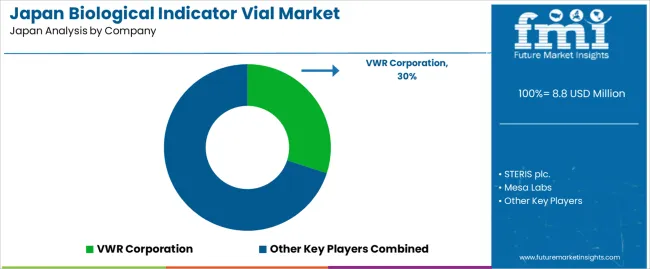The demand for biological indicator vials in Japan is projected to reach USD 12.4 million by 2035, reflecting an absolute increase of USD 3.6 million over the forecast period. Starting at USD 8.8 million in 2025, the demand is expected to grow at a steady CAGR of 3.5%. Biological indicator vials play a crucial role in the sterilization processes of pharmaceutical and healthcare industries by monitoring the effectiveness of sterilization treatments like autoclaving and irradiation. As the need for regulatory compliance and high-quality standards increases, the adoption of biological indicator vials is expected to rise, driving the growth of this industry.
The demand will be influenced by several key factors, including the expansion of healthcare infrastructure, stringent regulatory standards for sterilization, and the increasing emphasis on patient safety. The growth in the pharmaceutical and medical device industries in Japan, coupled with the increasing need for sterile environments in laboratories, hospitals, and manufacturing facilities, will drive the demand for biological indicator vials.

Innovations in biological indicators, such as the development of faster, more reliable vials, will support industry expansion. These innovations will ensure more efficient sterilization processes, particularly in settings where precision is critical for safety, such as in the pharmaceutical industry and surgical procedures.
The first inflection point occurs between 2025 and 2030, as the demand for biological indicator vials grows from USD 8.8 million to USD 9.1 million. This represents a moderate increase of USD 0.3 million during this phase, driven by the continued implementation of sterilization processes in industries such as healthcare and pharmaceuticals. The demand will be steady, with growth supported by the gradual adoption of more reliable sterilization practices. As industries face increasing regulations around sterilization, biological indicator vials will become an integral part of ensuring compliance with these standards. However, the growth rate during this period will remain modest, as sterilization processes and monitoring tools become well-established.
The second inflection point occurs between 2030 and 2035, when the demand for biological indicator vials rises sharply from USD 9.1 million to USD 12.4 million. This significant increase of USD 3.3 million, which represents approximately 91.7% of the total forecasted growth, reflects a more rapid acceleration in the demand for sterilization monitoring solutions. During this period, the demand for biological indicator vials will surge due to several factors: stricter regulatory requirements, innovations in sterilization technologies, and increasing investment in sterile environments, particularly in pharmaceuticals, medical devices, and hospitals.
| Metric | Value |
|---|---|
| Japan Biological Indicator Vial Sales Value (2025) | USD 8.8 million |
| Japan Biological Indicator Vial Forecast Value (2035) | USD 12.4 million |
| Japan Biological Indicator Vial Forecast CAGR (2025-2035) | 3.5% |
The demand for biological indicator vials in Japan is increasing as the need for sterilization monitoring becomes more critical in healthcare, pharmaceutical manufacturing, and laboratories. Biological indicators are essential for validating sterilization processes, ensuring that all pathogens are effectively eliminated, and meeting regulatory standards. With stringent quality and safety regulations in Japan, especially in sectors like medical devices, pharmaceuticals, and food production, the adoption of biological indicators has become standard practice.
In healthcare, particularly in hospitals and surgical centers, sterilization is a vital part of infection control protocols. The growing number of surgeries and medical procedures in Japan increases the demand for reliable and efficient sterilization verification. Pharmaceutical manufacturing, which also requires rigorous sterilization standards for drug production, further drives demand for biological indicator vials to ensure the safety and efficacy of medical products.
Advancements in sterilization technologies, improved test sensitivity, and quicker result times for biological indicators are making these systems even more valuable. With the ongoing emphasis on compliance, safety, and efficiency in the medical and pharmaceutical industries, the demand for biological indicator vials in Japan is expected to continue growing steadily over the next decade.
Demand is segmented by sterilization type, incubation time, and end use. By sterilization type, demand is divided into steam sterilization and ethylene oxide sterilization, with steam sterilization holding the largest share. In terms of incubation time, the industry is categorized into 24 to 32 hours, up to 24 hours, 32 to 48 hours, and above 48 hours. The industry is also segmented by end use, including pharmaceutical, food & beverages, and cosmetics. Regionally, demand is divided into Kanto, Kinki, Chubu, Kyushu & Okinawa, Tohoku, and the Rest of Japan.

Steam sterilization accounts for 57% of the demand for biological indicator vials in Japan. This method is widely used in industries such as pharmaceuticals and healthcare for sterilizing equipment, medical devices, and materials due to its effectiveness, cost-efficiency, and safety. Steam sterilization is capable of killing a broad spectrum of microorganisms, including bacteria and viruses, making it the preferred method for ensuring the sterility of products.
The demand for steam sterilization is driven by its widespread use in critical sectors like pharmaceuticals, where maintaining sterile conditions is essential for product safety and compliance with regulations. Biological indicator vials are used to test the effectiveness of the sterilization process, ensuring that all microbial life has been eradicated. As the pharmaceutical industry continues to grow, particularly with the rise in vaccine production and medical device manufacturing, the demand for steam sterilization and, consequently, biological indicator vials, will remain high in Japan.

The 24 to 32 hours incubation time category accounts for 45% of the demand for biological indicator vials in Japan. This range strikes a balance between providing sufficient time for microbial growth and maintaining a fast turnaround time for testing results. The 24 to 32 hours incubation period is ideal for detecting surviving microorganisms, ensuring the sterilization process has been effective.
This incubation time is widely used in industries like pharmaceuticals and healthcare, where quick results are essential for confirming sterilization efficiency and allowing for the continuation of production processes. The growing demand for rapid sterilization validation in high-volume manufacturing settings, such as in pharmaceutical production, further drives the popularity of the 24 to 32 hours incubation period. As sterilization processes become more standardized and efficient, the 24 to 32 hours incubation period remains the preferred option for ensuring compliance with regulatory standards and maintaining product quality.

The pharmaceutical industry accounts for 55% of the demand for biological indicator vials in Japan. In this industry, maintaining sterile conditions is crucial to ensuring the safety and efficacy of drugs, vaccines, and medical devices. Biological indicator vials are used to verify that sterilization processes, such as steam sterilization or ethylene oxide sterilization, have effectively eliminated microbial life from products and equipment.
As Japan's pharmaceutical sector grows, driven by innovations in drug production and medical treatments, the demand for biological indicator vials increases. The pharmaceutical industry is highly regulated, and ensuring compliance with stringent quality control standards requires regular validation of sterilization procedures. Biological indicator vials are indispensable in this process, as they provide reliable confirmation that sterilization procedures have met the necessary standards. With the rise in biotechnology and pharmaceutical manufacturing in Japan, the pharmaceutical industry will continue to drive demand for biological indicator vials for years to come.
Biological indicator vials are used to verify effective sterilisation cycles (steam, EtO, H₂O₂) and support regulatory compliance. Key drivers include the expansion of sterile manufacturing (especially biologics and single‑use systems), rising infection‑control standards in hospitals and rigorous Japanese regulatory frameworks requiring validated sterilisation. Restraints include the high cost of advanced rapid‑read or automated indicator vials, the complexity of validation protocols across diverse sterilisation methods and the relatively slow replacement cycles in well‑established facilities.
Why is Demand for Biological Indicator Vials Growing in Japan?
Demand is growing in Japan because hospitals, pharmaceutical firms and device manufacturers are under greater pressure to ensure sterility and patient safety under stringent national standards. Japan’s pharmaceutical and biologic production sectors are expanding, increasing the need for rigorous sterilisation verification tools. The healthcare system’s focus on preventing healthcare‑associated infections (HAIs) and reducing sterilisation cycle times places biological indicator vials in critical workflows. These factors combine to make biological indicator vials a vital consumable in Japan’s quality‑assurance and compliance infrastructure.
How are Technological Innovations Driving Growth of Biological Indicator Vials in Japan?
Technological advances are driving growth in Japan by enhancing performance, usability and integration of biological indicator vials. Innovations such as rapid‑read indicators that shorten incubation time, self‑contained formats with spore and media in one vial, and digital traceability features align with Japanese manufacturers’ demand for efficiency and precision. Improved vial formats that support various sterilisation types and automated read‑out systems reduce manual handling and speed workflows making these products more appealing in Japan’s advanced manufacturing and medical‑device sectors.
What are the Key Challenges Limiting Adoption of Biological Indicator Vials in Japan?
Despite positive drivers, several challenges limit wider adoption in Japan. A major barrier is the higher cost of premium indicator vials especially for facilities that still use legacy products or simpler methods. Validation and training complexity is another issue, as integrating new formats (rapid‑read, digital) requires changes in workflows, staff training and quality‑system updates. The diversity of sterilisation methods used (steam, EtO, H₂O₂) means facilities may need multiple indicator formats, increasing complexity. Finally, the long lifecycle of existing equipment may slow upgrades or replacements of indicator formats, limiting penetration of newer technologies.

| Region | CAGR (%) |
|---|---|
| Kyushu & Okinawa | 4.3% |
| Kanto | 4.0% |
| Kinki | 3.5% |
| Chubu | 3.1% |
| Tohoku | 2.7% |
| Rest of Japan | 2.6% |
The demand for biological indicator vials in Japan is rising across all regions, with Kyushu & Okinawa leading at a 4.3% CAGR due to growing emphasis on sterilization standards in hospitals and laboratories. Kanto follows at 4.0%, supported by advanced healthcare facilities and high volumes of medical procedures. Kinki shows a 3.5% CAGR driven by expanding clinical operations in Osaka and Kyoto. Chubu records a 3.1% CAGR as its healthcare sector strengthens through modernization initiatives. Tohoku and the Rest of Japan see moderate growth at 2.7% and 2.6%, respectively, as smaller facilities gradually upgrade sterilization practices.
Kyushu & Okinawa is experiencing the highest demand growth for biological indicator vials in Japan, with a 4.3% CAGR. The region's growth is primarily driven by the increasing focus on stringent sterilization protocols in healthcare and laboratory settings. Kyushu, with cities like Fukuoka, is home to several hospitals and medical centers that are investing in advanced sterilization systems to ensure the highest standards of safety for patients, particularly in surgical and pharmaceutical environments.
The region’s growing pharmaceutical and biotech industries are also contributing to the rise in demand, as these sectors require biological indicator vials for sterilization validation and quality control. Okinawa is seeing improvements in healthcare infrastructure, leading to better access to advanced sterilization technologies and higher adoption rates for biological indicator vials. With increasing awareness of the importance of contamination control and sterilization in medical and research fields, Kyushu & Okinawa are expected to continue driving growth in biological indicator vial usage.

Kanto is experiencing strong demand for biological indicator vials, with a 4.0% CAGR, driven by its concentration of advanced healthcare facilities, research institutions, and high-tech industries. Tokyo, as a major hub for both medical and technological innovations, plays a significant role in the adoption of sterilization systems that require biological indicators for ensuring sterility. Hospitals, laboratories, and pharmaceutical companies in the region are increasingly using biological indicator vials to meet rigorous sterilization standards.
The region’s well-established healthcare infrastructure, alongside its emphasis on safety and quality in both medical and industrial applications, fuels the demand for biological indicator vials. As the need for sterilization validation grows across various sectors, from healthcare to food production, Kanto remains at the forefront of the biological indicator vial industry. The region’s continued investment in medical technologies and its expanding research and healthcare sectors ensure that the demand for biological indicator vials will remain strong in the foreseeable future.
Kinki is seeing steady growth in the demand for biological indicator vials, with a 3.5% CAGR. The region, which includes Osaka and Kyoto, is home to some of Japan’s largest pharmaceutical companies and hospitals, driving the adoption of sterilization practices. With a strong focus on medical safety and quality control, healthcare institutions in Kinki increasingly rely on biological indicator vials for sterilization validation, particularly in surgery, pharmaceutical manufacturing, and laboratory operations.
The Kinki region’s growing healthcare infrastructure, combined with its well-established pharmaceutical and biotechnology sectors, supports the use of biological indicators as an essential component of sterilization protocols. As demand for sterile environments in medical, research, and industrial settings increases, Kinki’s adoption of biological indicator vials will continue to grow. With a regional emphasis on improving patient safety and meeting international standards, Kinki is positioned to remain a significant industry for biological indicator vials in Japan.
Chubu is experiencing moderate growth in the demand for biological indicator vials, with a 3.1% CAGR. The region’s industrial base, particularly in manufacturing and healthcare, is driving the adoption of sterilization technologies that require biological indicators. Cities like Nagoya, with their significant industrial and medical sectors, are increasingly focusing on improving sterilization practices in hospitals, laboratories, and research centers.
Chubu’s growth in biological indicator vial usage is influenced by the expanding healthcare services and the rise of cleanroom applications in sectors like pharmaceuticals and food processing. As the region continues to modernize its healthcare and manufacturing sectors, the adoption of biological indicator vials will continue to rise. The increasing focus on quality assurance and compliance with global sterilization standards in these industries contributes to steady growth in Chubu’s demand for biological indicator vials, helping the region meet both domestic and international safety standards.
Tohoku is seeing moderate growth in demand for biological indicator vials, with a 2.7% CAGR. The region’s growth is primarily driven by investments in healthcare infrastructure and the increasing need for sterilization systems in medical facilities. As hospitals and clinics in Tohoku continue to modernize, they are adopting more advanced sterilization methods, leading to greater use of biological indicator vials for validating sterility.
The region’s focus on improving healthcare access, especially in rural areas, and its ongoing efforts to enhance the quality of medical services are contributing to the rise in demand for biological indicator vials. Tohoku’s healthcare providers are increasingly prioritizing patient safety and compliance with national sterilization standards, driving the adoption of these vials. As Tohoku continues to improve its medical infrastructure and embrace modern sterilization technologies, the demand for biological indicator vials is expected to grow steadily, ensuring safe and effective patient care.
The Rest of Japan is experiencing steady demand for biological indicator vials, with a 2.6% CAGR. The growth in this region is driven by ongoing improvements in healthcare infrastructure and an increasing focus on sterile environments in medical and laboratory settings. While not as central to Japan’s healthcare industry as Kanto or Kyushu & Okinawa, the Rest of Japan is seeing greater adoption of sterilization technologies as local healthcare facilities modernize their operations.
National government initiatives to improve healthcare access and quality are also contributing to this growth. As smaller hospitals and clinics adopt more advanced sterilization practices and raise awareness about the importance of sterility in medical procedures, the demand for biological indicator vials continues to rise. With improvements in healthcare standards and greater emphasis on patient safety, the Rest of Japan is expected to see continued, steady growth in biological indicator vial usage.

Demand for biological indicator vials in Japan is poised for growth amid heightened requirements for sterilization validation across healthcare facilities, pharmaceutical manufacturing, and medical device production. As Japan’s regulatory environment continues to enforce strict sterilization and contamination-control standards, facilities are increasingly investing in reliable biological indicators especially vial formats used to verify sterilization efficacy and ensure patient safety.
In Japan’s demand landscape, VWR Corporation holds an estimated 30.0% share, reflecting its leading role in supplying biological indicator vials to Japanese users and its strong distribution network in the region. Other key players servicing Japanese demand include STERIS plc., Mesa Labs, 3M Company, and Siltex Australia, each providing indicator vials and related monitoring solutions tailored to Japan’s requirements for high quality and compliance.
The major drivers of demand in Japan include the expansion of sterile manufacturing operations (pharmaceutical, biotech and medical device), increasing procedures in hospitals, and the emphasis on infection prevention and validation protocols. Japan’s advanced healthcare infrastructure and modular sterilization facilities support the adoption of high-performance consumables like biological indicator vials. While cost and regulatory logistics remain considerations, the outlook for Japan’s demand for biological indicator vials remains strong, supported by ongoing focus on sterilization quality and compliance in critical sectors.
| Items | Values |
|---|---|
| Quantitative Unit | USD million |
| Sterilization Type | Steam Sterilization, Ethylene Oxide Sterilization |
| Incubation Time | 24 to 32 Hours, Up to 24 Hours, 32 to 48 Hours, Above 48 Hours |
| End Use | Pharmaceutical, Food & Beverages, Cosmetics |
| Regions Covered | Kyushu & Okinawa, Kanto, Kinki, Chubu, Tohoku, Rest of Japan |
| Key Players Profiled | VWR Corporation, STERIS plc., Mesa Labs, 3M Company, Siltex Australia |
| Additional Attributes | Dollar sales by sterilization type, incubation time, end use, and regional trends with a focus on pharmaceutical and food & beverage sectors |
The global demand for biological indicator vial in japan is estimated to be valued at USD 8.8 million in 2025.
The market size for the demand for biological indicator vial in japan is projected to reach USD 12.4 million by 2035.
The demand for biological indicator vial in japan is expected to grow at a 3.5% CAGR between 2025 and 2035.
The key product types in demand for biological indicator vial in japan are steam sterilization and ethylene oxide sterilization.
In terms of incubation time, 24 to 32 hours segment to command 45.0% share in the demand for biological indicator vial in japan in 2025.






Our Research Products

The "Full Research Suite" delivers actionable market intel, deep dives on markets or technologies, so clients act faster, cut risk, and unlock growth.

The Leaderboard benchmarks and ranks top vendors, classifying them as Established Leaders, Leading Challengers, or Disruptors & Challengers.

Locates where complements amplify value and substitutes erode it, forecasting net impact by horizon

We deliver granular, decision-grade intel: market sizing, 5-year forecasts, pricing, adoption, usage, revenue, and operational KPIs—plus competitor tracking, regulation, and value chains—across 60 countries broadly.

Spot the shifts before they hit your P&L. We track inflection points, adoption curves, pricing moves, and ecosystem plays to show where demand is heading, why it is changing, and what to do next across high-growth markets and disruptive tech

Real-time reads of user behavior. We track shifting priorities, perceptions of today’s and next-gen services, and provider experience, then pace how fast tech moves from trial to adoption, blending buyer, consumer, and channel inputs with social signals (#WhySwitch, #UX).

Partner with our analyst team to build a custom report designed around your business priorities. From analysing market trends to assessing competitors or crafting bespoke datasets, we tailor insights to your needs.
Supplier Intelligence
Discovery & Profiling
Capacity & Footprint
Performance & Risk
Compliance & Governance
Commercial Readiness
Who Supplies Whom
Scorecards & Shortlists
Playbooks & Docs
Category Intelligence
Definition & Scope
Demand & Use Cases
Cost Drivers
Market Structure
Supply Chain Map
Trade & Policy
Operating Norms
Deliverables
Buyer Intelligence
Account Basics
Spend & Scope
Procurement Model
Vendor Requirements
Terms & Policies
Entry Strategy
Pain Points & Triggers
Outputs
Pricing Analysis
Benchmarks
Trends
Should-Cost
Indexation
Landed Cost
Commercial Terms
Deliverables
Brand Analysis
Positioning & Value Prop
Share & Presence
Customer Evidence
Go-to-Market
Digital & Reputation
Compliance & Trust
KPIs & Gaps
Outputs
Full Research Suite comprises of:
Market outlook & trends analysis
Interviews & case studies
Strategic recommendations
Vendor profiles & capabilities analysis
5-year forecasts
8 regions and 60+ country-level data splits
Market segment data splits
12 months of continuous data updates
DELIVERED AS:
PDF EXCEL ONLINE
Demand Signal Repository Solutions Market Size and Share Forecast Outlook 2025 to 2035
Demand Side Management Market Size and Share Forecast Outlook 2025 to 2035
Demand Response Market Analysis - Size, Share, and Forecast Outlook 2025 to 2035
North America Shipping Supplies Market Trends – Innovations & Growth 2024-2034
Demand of Kozani Saffron in Greece Analysis - Size, Share & Forecast 2025 to 2035
Demand of No-acid Whey Strained Dairy Processing Concepts in European Union Size and Share Forecast Outlook 2025 to 2035
Demand for Bronte Pistachio in Italy Analysis - Size, Share & Forecast 2025 to 2035
Demand and Trend Analysis of Gaming Monitor in Western Europe Size and Share Forecast Outlook 2025 to 2035
Demand and Trend Analysis of Gaming Monitor in Korea Size and Share Forecast Outlook 2025 to 2035
Demand and Trend Analysis of Gaming Monitor in Japan Size and Share Forecast Outlook 2025 to 2035
Glycine Soja (Soybean) Seed Extract Market Size and Share Forecast Outlook 2025 to 2035
Demand and Trend Analysis of Yeast in Japan - Size, Share, and Forecast Outlook 2025 to 2035
Demand of Pistachio-based desserts & ingredients in France Analysis - Size, Share & Forecast 2025 to 2035
Western Europe Men’s Skincare Market Analysis – Forecast 2023-2033
Demand and Trends Analysis of Stevia in Japan Size and Share Forecast Outlook 2025 to 2035
Japan Women’s Intimate Care Market Trends – Growth & Forecast 2024-2034
Demand and Trend Analysis of Fabric Stain Remover in Korea Size and Share Forecast Outlook 2025 to 2035
Demand and Sales Analysis of Paper Cup in Korea Size and Share Forecast Outlook 2025 to 2035
Demand and Sales Analysis of Paper Cup in Western Europe Size and Share Forecast Outlook 2025 to 2035
Demand of MFGM-enriched Powders & RTDs in European Union Size and Share Forecast Outlook 2025 to 2035

Thank you!
You will receive an email from our Business Development Manager. Please be sure to check your SPAM/JUNK folder too.
Chat With
MaRIA